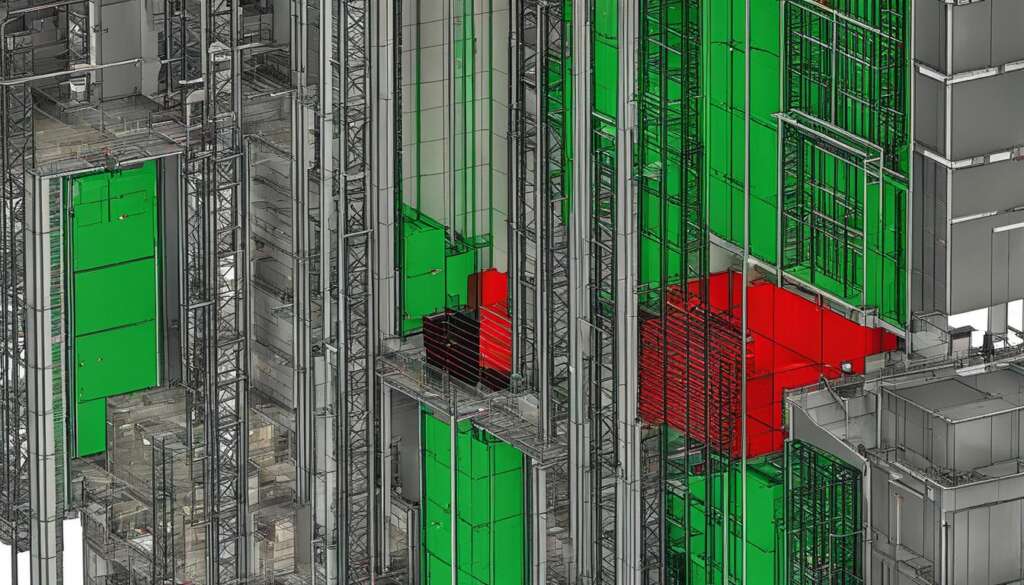Table of Contents
In today’s fast-paced world, cellular communication coverage is vital in ensuring connectedness and seamless communication. However, some areas may have limited signal strength and poor connectivity, leading to dropped calls, slow data speeds, and compromised emergency communication coverage. This is where a distributed antenna system (DAS) comes in handy.
A DAS system is a network of antennas designed to improve signal strength and distribution in large buildings, stadiums, and public spaces. It ensures dependable cellular and emergency communication coverage, allowing individuals to stay connected and communicate freely without hassle.
Key Takeaways
- A DAS system is a network of antennas designed to provide cellular and emergency communication coverage in areas with limited signal strength.
- DAS systems are essential in large buildings, stadiums, and public spaces where signal distribution is a challenge.
- A well-designed DAS system ensures reliable connectivity and seamless communication for individuals.
- A DAS system comprises various components, including signal sources, fiber optic cables, and remote units.
- The operation of a DAS system involves signal distribution through a network of antennas and signal amplification to enhance coverage.
Key Features of a DAS System
A distributed antenna system, commonly known as a DAS system, is a vital piece of infrastructure that allows for reliable cellular and emergency communication coverage in various environments. Here, we’ll explore some of the key features of a well-designed DAS system, including:
- Enhanced signal strength and coverage: By amplifying signals and ensuring effective distribution through a network of antennas, a DAS system can improve connectivity in areas where poor signal strength is a concern, such as large buildings, stadiums, and public spaces.
- Scalability: DAS systems can be scaled up or down as needed, depending on the size and needs of the environment in which they are deployed.
- Flexibility: DAS systems can be tailored to meet the specific cellular and emergency communication needs of a given environment, ensuring maximum coverage and reliability.
- Reliability: Because DAS systems are designed to provide redundancy and failover capabilities, they offer a high degree of reliability in even the most demanding conditions.
- Cost-effectiveness: While the initial investment in a DAS system can be significant, the long-term cost savings associated with improved cellular and emergency communication coverage can be substantial.
A well-designed DAS system is essential for achieving seamless connectivity and communication in environments where strong, reliable signal strength is critical. By leveraging the key features of a DAS system, organizations can ensure they have the flexibility, scalability, and reliability needed to meet the ever-evolving demands of modern communication technology.
Understanding the Operation of a DAS System
In simple terms, a Distributed Antenna System (DAS) functions to improve cellular communication coverage and public safety wireless communication within designated areas. To achieve this, a DAS system receives and distributes signals through a network of antennas that are placed strategically to minimize signal interference and enhance connectivity.
One of the critical components of a DAS system is signal distribution, which involves the transmission of signals between network nodes to amplify signals and improve coverage. The DAS system receives signals from a signal source, such as a cellular network or public safety network, and distributes them through a series of fiber optic cables to various remote units located throughout the designated coverage area. In essence, the DAS system acts as a proxy between the signal source and remote units to extend coverage and improve signal quality.
To fully understand the operation of a DAS system, let’s examine the essential components of signal distribution. These include:
| Component | Description |
|---|---|
| Signal Source | The original location of the signal transmission, usually a cellular or public safety network. |
| Fiber Optic Cables | The medium through which the signal travels throughout the DAS system, connecting the signal source to the remote units. |
| Remote Units | The endpoint of signal distribution, which receives and amplifies the signal to improve coverage and signal quality within the designated area. |
By understanding the operation of a DAS system and the role of signal distribution, it becomes evident why the proper configuration and installation of a DAS system are vital in providing reliable connectivity and communication.
Conclusion
In conclusion, it is evident that a DAS system is a crucial technology in today’s world to ensure seamless connectivity and communication. By providing both cellular and emergency communication coverage, the system plays a vital role in improving signal strength and coverage in large buildings, stadiums, and public spaces.
We have explored the key features of a DAS system, which works through a network of antennas and amplifies signals to enhance coverage within a designated area. The system’s operation relies on various components, including signal sources, fiber optic cables, and remote units, to ensure effective signal distribution.
Therefore, it is imperative to invest in a well-designed and reliable DAS system to cater to the communication needs of today’s fast-paced world. It is hoped that this article has provided valuable insights into the essentials of a DAS system, and the critical role it plays in providing reliable cellular and emergency communication coverage.
FAQ
What is a DAS system?
A DAS system, also known as a distributed antenna system, is a network of antennas that improves cellular and emergency communication coverage in various environments.
How does a DAS system work?
A DAS system receives signals from a cellular or public safety network, distributes them through a network of antennas, and amplifies them to enhance coverage within a designated area.
What are the key features of a DAS system?
The key features of a DAS system include improved signal strength and coverage in large buildings, stadiums, and public spaces. It caters to both cellular and emergency communication needs.
What components are involved in the signal distribution process of a DAS system?
The signal distribution process of a DAS system involves signal sources, fiber optic cables, and remote units. These components work together to distribute and amplify signals to enhance coverage.













